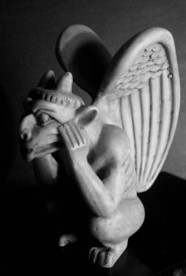I was talking the other day about how tricky it can be to teach the comics-illiterate how to read comics, and how Bryan Talbot deliberately created The Tale of One Bad Rat with such people in mind. The storytelling is straightforward, the art naturalistic, the dialogue kept to a minimum, and the panels devoid of the comics-specific conventions that have grown up as a form of narrative shorthand over the decades. That's not to say it's crudely simple; on the contrary, it's both subtle and sophisticated. It is, frankly, about as good an introduction to what comics can be as one could hope to find.
Among the handful of other comics I like to show friends who are sceptical about what comics can do is Jeff Smith's Bone, which could hardly be more different from One Bad Rat. Here's a page from it, as a taster:
And if you think that's simple, you should take a look at the analysis of Smith's storytelling over here. You'll also see what happens next.
Clear and perfectly-paced, owing a lot to animation but not shackled by it, inspired in its look by the comics of Carl Barks and -- especially -- Walt Kelly, Bone is a hilarious and thrilling hybrid of Tolkien and Disney at its best. It tells the story of the three Bone cousins -- greedy Phoney, goofy Smiley, and everyman Fone, all of whom Smith had first drawn when he was a child -- who, having been run out of their own town after one of Phoney's corrupt scams goes wrong, get lost and find themselves in a lush and idyllic fantasy valley, complete with talking animals, burly barmen, grouchy old ladies, and a pretty redhead. It swiftly becomes clear that things in the valley aren't as rosy as they might appear, and that it has a dark past waiting to rear its head, and thus begins a story that as Time magazine said, is 'as sweeping as The Lord of the Rings cycle, but much funnier.'
Comparisons with The Lord of the Rings really aren't all that silly, given that Bone is a classic fantasy and is, indisputably, a very big book. As Neil Gaiman said of the collected edition back in the day, 'It's the height of a trade paperback, and over 1300 pages long. It looks rather intimidating in that format -- it looks like the epic fantasy novel that it is. A perfect gift, too.' Originally published in black and white, it's recently been coloured, which makes for a novel reading experience. I'm not sure that I think the colour's an improvement,* but it certainly does no harm, and adds an extra level to the storytelling, one that'll surely be picked up in the oft-promised film.
_____________________________________________________
* Is it even possible to improve on this? This is, surely, up there with the greatest panels ever.


No comments:
Post a Comment